sport mode Hyundai Accent 2012 Owner's Manual
[x] Cancel search | Manufacturer: HYUNDAI, Model Year: 2012, Model line: Accent, Model: Hyundai Accent 2012Pages: 370
Page 210 of 370
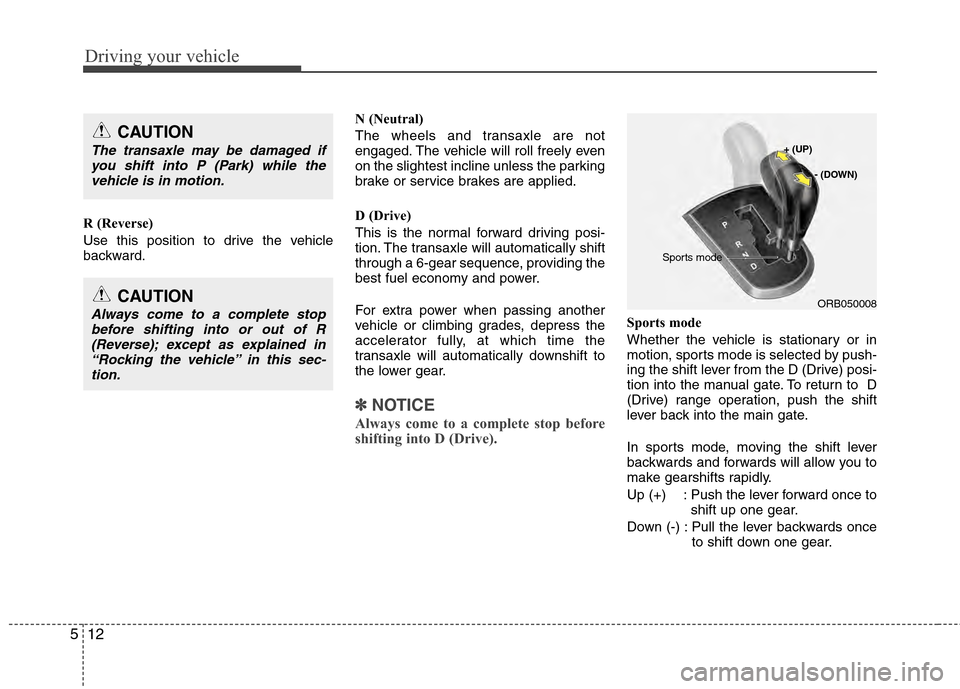
Driving your vehicle
12
5
R (Reverse)
Use this position to drive the vehicle
backward. N (Neutral)
The wheels and transaxle are not
engaged. The vehicle will roll freely even
on the slightest incline unless the parking
brake or service brakes are applied.
D (Drive)
This is the normal forward driving posi-
tion. The transaxle will automatically shift
through a 6-gear sequence, providing the
best fuel economy and power.
For extra power when passing another
vehicle or climbing grades, depress the
accelerator fully, at which time the
transaxle will automatically downshift to
the lower gear.
✽ ✽
NOTICE
Always come to a complete stop before
shifting into D (Drive).
Sports mode
Whether the vehicle is stationary or in
motion, sports mode is selected by push-
ing the shift lever from the D (Drive) posi-
tion into the manual gate. To return to D
(Drive) range operation, push the shift
lever back into the main gate.
In sports mode, moving the shift lever
backwards and forwards will allow you to
make gearshifts rapidly.
Up (+) : Push the lever forward once to
shift up one gear.
Down (-) : Pull the lever backwards once to shift down one gear.
CAUTION
Always come to a complete stopbefore shifting into or out of R(Reverse); except as explained in“Rocking the vehicle” in this sec-tion.ORB050008
+ (UP)
- (DOWN)
Sports mode
CAUTION
The transaxle may be damaged ifyou shift into P (Park) while thevehicle is in motion.
Page 211 of 370
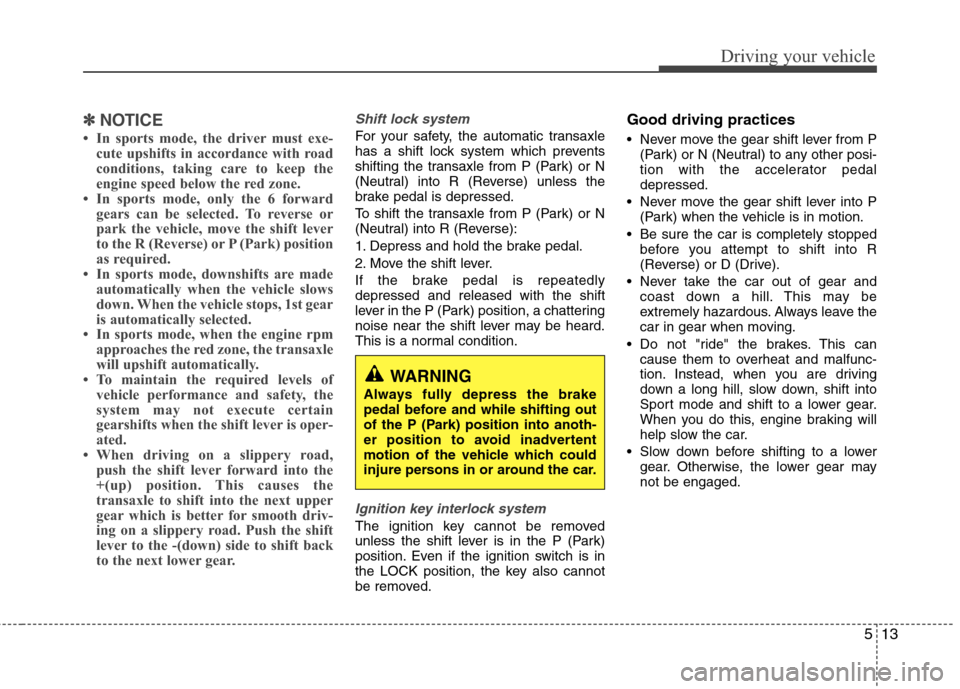
513
Driving your vehicle
✽
✽NOTICE
• In sports mode, the driver must exe-
cute upshifts in accordance with road
conditions, taking care to keep the
engine speed below the red zone.
• In sports mode, only the 6 forward gears can be selected. To reverse or
park the vehicle, move the shift lever
to the R (Reverse) or P (Park) position
as required.
• In sports mode, downshifts are made automatically when the vehicle slows
down. When the vehicle stops, 1st gear
is automatically selected.
• In sports mode, when the engine rpm approaches the red zone, the transaxle
will upshift automatically.
• To maintain the required levels of vehicle performance and safety, the
system may not execute certain
gearshifts when the shift lever is oper-
ated.
• When driving on a slippery road, push the shift lever forward into the
+(up) position. This causes the
transaxle to shift into the next upper
gear which is better for smooth driv-
ing on a slippery road. Push the shift
lever to the -(down) side to shift back
to the next lower gear.
Shift lock system
For your safety, the automatic transaxle
has a shift lock system which prevents
shifting the transaxle from P (Park) or N
(Neutral) into R (Reverse) unless the
brake pedal is depressed.
To shift the transaxle from P (Park) or N
(Neutral) into R (Reverse):
1. Depress and hold the brake pedal.
2. Move the shift lever.
If the brake pedal is repeatedly
depressed and released with the shift
lever in the P (Park) position, a chattering
noise near the shift lever may be heard.
This is a normal condition.
Ignition key interlock system
The ignition key cannot be removed
unless the shift lever is in the P (Park)
position. Even if the ignition switch is in
the LOCK position, the key also cannot
be removed.
Good driving practices
Never move the gear shift lever from P
(Park) or N (Neutral) to any other posi-
tion with the accelerator pedal
depressed.
Never move the gear shift lever into P (Park) when the vehicle is in motion.
Be sure the car is completely stopped before you attempt to shift into R
(Reverse) or D (Drive).
Never take the car out of gear and coast down a hill. This may be
extremely hazardous. Always leave the
car in gear when moving.
Do not "ride" the brakes. This can cause them to overheat and malfunc-
tion. Instead, when you are driving
down a long hill, slow down, shift into
Sport mode and shift to a lower gear.
When you do this, engine braking will
help slow the car.
Slow down before shifting to a lower gear. Otherwise, the lower gear may
not be engaged.
WARNING
Always fully depress the brake
pedal before and while shifting out
of the P (Park) position into anoth-
er position to avoid inadvertent
motion of the vehicle which could
injure persons in or around the car.
Page 229 of 370
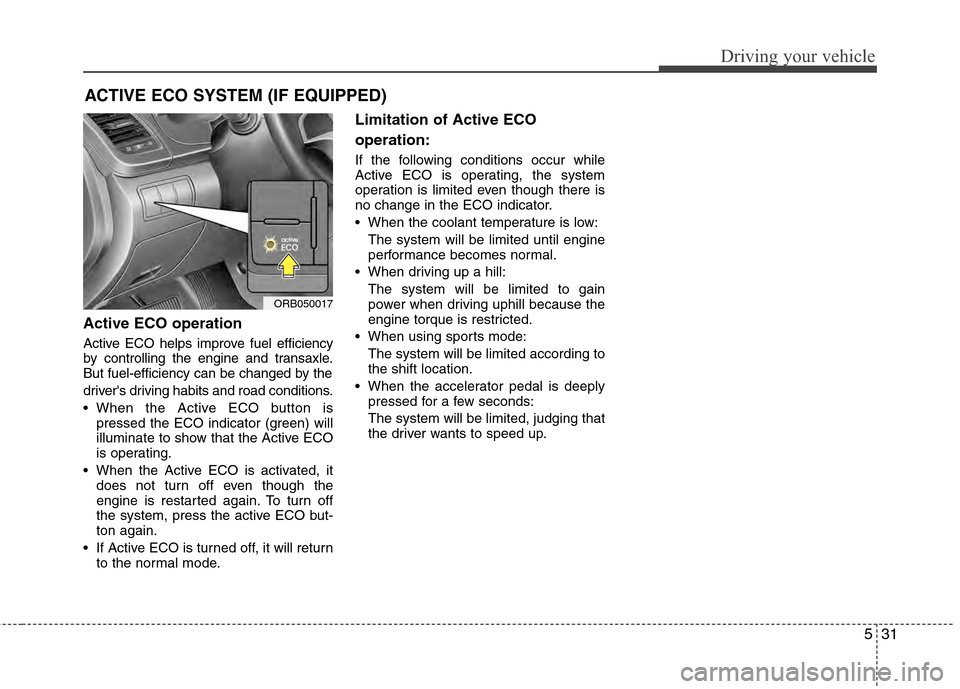
531
Driving your vehicle
Active ECO operation
Active ECO helps improve fuel efficiency
by controlling the engine and transaxle.
But fuel-efficiency can be changed by the
driver's driving habits and road conditions.
When the Active ECO button ispressed the ECO indicator (green) will
illuminate to show that the Active ECO
is operating.
When the Active ECO is activated, it does not turn off even though the
engine is restarted again. To turn off
the system, press the active ECO but-
ton again.
If Active ECO is turned off, it will return to the normal mode.
Limitation of Active ECO
operation:
If the following conditions occur while
Active ECO is operating, the system
operation is limited even though there is
no change in the ECO indicator.
When the coolant temperature is low:
The system will be limited until engine
performance becomes normal.
When driving up a hill: The system will be limited to gain
power when driving uphill because the
engine torque is restricted.
When using sports mode: The system will be limited according to
the shift location.
When the accelerator pedal is deeply pressed for a few seconds:
The system will be limited, judging that
the driver wants to speed up.
ACTIVE ECO SYSTEM (IF EQUIPPED)
ORB050017
Page 322 of 370
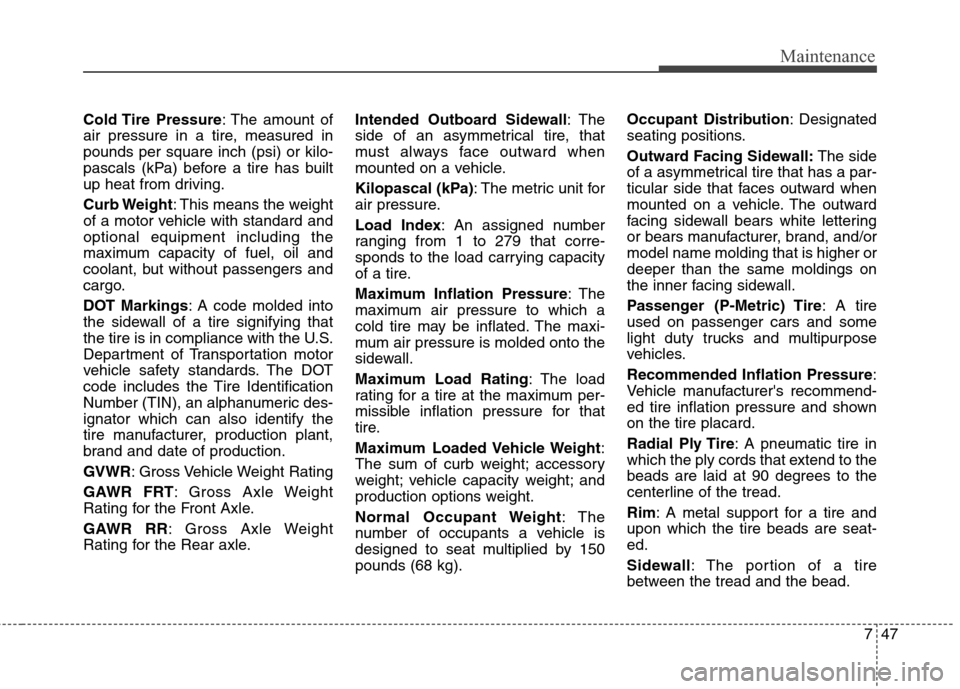
747
Maintenance
Cold Tire Pressure: The amount of
air pressure in a tire, measured in
pounds per square inch (psi) or kilo-
pascals (kPa) before a tire has built
up heat from driving.
Curb Weight: This means the weight
of a motor vehicle with standard and
optional equipment including the
maximum capacity of fuel, oil and
coolant, but without passengers and
cargo.
DOT Markings: A code molded into
the sidewall of a tire signifying that
the tire is in compliance with the U.S.
Department of Transportation motor
vehicle safety standards. The DOT
code includes the Tire Identification
Number (TIN), an alphanumeric des-
ignator which can also identify the
tire manufacturer, production plant,
brand and date of production.
GVWR: Gross Vehicle Weight Rating
GAWR FRT: Gross Axle Weight
Rating for the Front Axle.
GAWR RR: Gross Axle Weight
Rating for the Rear axle.Intended Outboard Sidewall
: The
side of an asymmetrical tire, that
must always face outward when
mounted on a vehicle.
Kilopascal (kPa): The metric unit for
air pressure.
Load Index: An assigned number
ranging from 1 to 279 that corre-
sponds to the load carrying capacity
of a tire.
Maximum Inflation Pressure : The
maximum air pressure to which a
cold tire may be inflated. The maxi-
mum air pressure is molded onto the
sidewall.
Maximum Load Rating : The load
rating for a tire at the maximum per-
missible inflation pressure for that
tire.
Maximum Loaded Vehicle Weight:
The sum of curb weight; accessory
weight; vehicle capacity weight; and
production options weight.
Normal Occupant Weight:The
number of occupants a vehicle is
designed to seat multiplied by 150
pounds (68 kg). Occupant Distribution
: Designated
seating positions.
Outward Facing Sidewall: The side
of a asymmetrical tire that has a par-
ticular side that faces outward when
mounted on a vehicle. The outward
facing sidewall bears white lettering
or bears manufacturer, brand, and/or
model name molding that is higher or
deeper than the same moldings on
the inner facing sidewall.
Passenger (P-Metric) Tire : A tire
used on passenger cars and some
light duty trucks and multipurpose
vehicles.
Recommended Inflation Pressure :
Vehicle manufacturer's recommend-
ed tire inflation pressure and shown
on the tire placard.
Radial Ply Tire : A pneumatic tire in
which the ply cords that extend to the
beads are laid at 90 degrees to the
centerline of the tread.
Rim: A metal support for a tire and
upon which the tire beads are seat-
ed.
Sidewall: The portion of a tire
between the tread and the bead.
Page 363 of 370
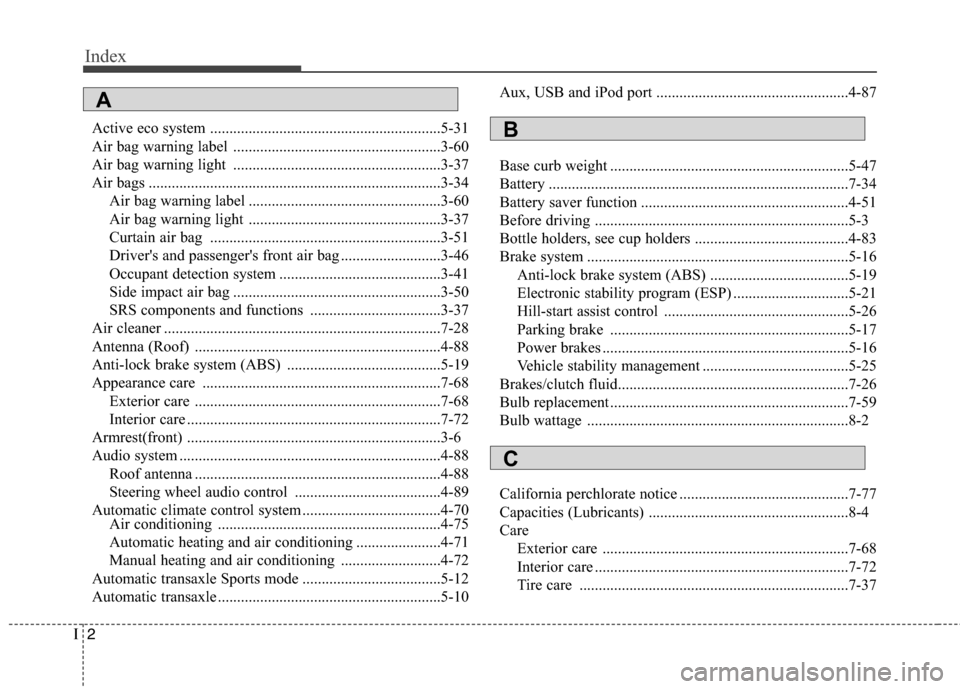
Index
2I
Active eco system ............................................................5-31
Air bag warning label ......................................................3-60
Air bag warning light ......................................................3-37
Air bags ........................................................................\
....3-34Air bag warning label ..................................................3-60
Air bag warning light ..................................................3-37
Curtain air bag ............................................................3-51
Driver's and passenger's front air bag ..........................3-46
Occupant detection system ..........................................3-41
Side impact air bag ......................................................3-50
SRS components and functions ..................................3-37
Air cleaner ........................................................................\
7-28
Antenna (Roof) ................................................................4-88
Anti-lock brake system (ABS) ........................................5-19
Appearance care ..............................................................7-68 Exterior care ................................................................7-68
Interior care ..................................................................7-72
Armrest(front) ..................................................................3-6
Audio system ....................................................................4-88\
Roof antenna ................................................................4-88
Steering wheel audio control ......................................4-89
Automatic climate control system ....................................4-70 Air conditioning ..........................................................4-75
Automatic heating and air conditioning ......................4-71
Manual heating and air conditioning ..........................4-72
Automatic transaxle Sports mode ....................................5-12
Automatic transaxle ..........................................................5-10 Aux, USB and iPod port ..................................................4-87
Base curb weight ..............................................................5-47
Battery ........................................................................\
......7-34
Battery saver function ......................................................4-51
Before driving ..................................................................5-3
Bottle holders, see cup holders ........................................4-83
Brake system ....................................................................5-16\
Anti-lock brake system (ABS) ....................................5-19
Electronic stability program (ESP) ..............................5-21
Hill-start assist control ................................................5-26
Parking brake ..............................................................5-17
Power brakes ................................................................5-16
Vehicle stability management ......................................5-25
Brakes/clutch fluid............................................................7-26
Bulb replacement ..............................................................7-59
Bulb wattage ....................................................................8-2
California perchlorate notice ............................................7-77
Capacities (Lubricants) ....................................................8-4
Care Exterior care ................................................................7-68
Interior care ..................................................................7-72
Tire care ......................................................................7-\
37
A
B
C
Page 369 of 370
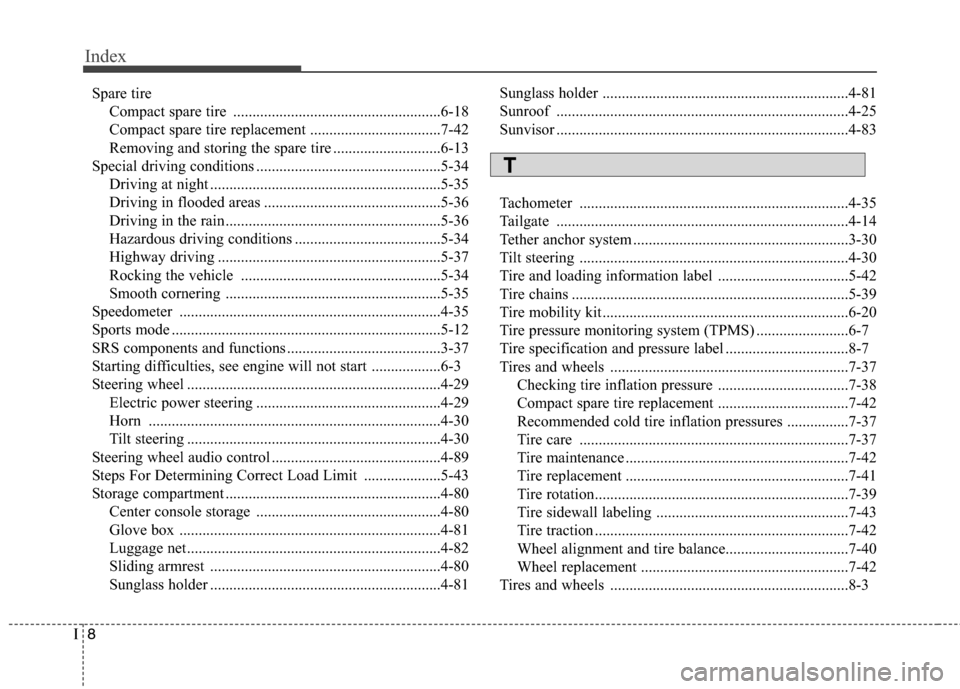
Index
8I
Spare tireCompact spare tire ......................................................6-18
Compact spare tire replacement ..................................7-42
Removing and storing the spare tire ............................6-13
Special driving conditions ................................................5-34 Driving at night ............................................................5-35
Driving in flooded areas ..............................................5-36
Driving in the rain ........................................................5-36
Hazardous driving conditions ......................................5-34
Highway driving ..........................................................5-37
Rocking the vehicle ....................................................5-34
Smooth cornering ........................................................5-35
Speedometer ....................................................................4-35\
Sports mode ......................................................................5-\
12
SRS components and functions ........................................3-37
Starting difficulties, see engine will not start ..................6-3
Steering wheel ..................................................................4-29 Electric power steering ................................................4-29
Horn ........................................................................\
....4-30
Tilt steering ..................................................................4-30
Steering wheel audio control ............................................4-89
Steps For Determining Correct Load Limit ....................5-43
Storage compartment ........................................................4-80 Center console storage ................................................4-80
Glove box ....................................................................4-81\
Luggage net..................................................................4-82
Sliding armrest ............................................................4-80
Sunglass holder ............................................................4-81 Sunglass holder ................................................................4-81
Sunroof ........................................................................\
....4-25
Sunvisor ........................................................................\
....4-83
Tachometer ......................................................................4-\
35
Tailgate ........................................................................\
....4-14
Tether anchor system ........................................................3-30
Tilt steering ......................................................................4-\
30
Tire and loading information label ..................................5-42
Tire chains ........................................................................\
5-39
Tire mobility kit ................................................................6-20
Tire pressure monitoring system (TPMS) ........................6-7
Tire specification and pressure label ................................8-7
Tires and wheels ..............................................................7-37
Checking tire inflation pressure ..................................7-38
Compact spare tire replacement ..................................7-42
Recommended cold tire inflation pressures ................7-37
Tire care ......................................................................7-\
37
Tire maintenance ..........................................................7-42
Tire replacement ..........................................................7-41
Tire rotation..................................................................7-39
Tire sidewall labeling ..................................................7-43
Tire traction ..................................................................7-42
Wheel alignment and tire balance................................7-40
Wheel replacement ......................................................7-42
Tires and wheels ..............................................................8-3
T